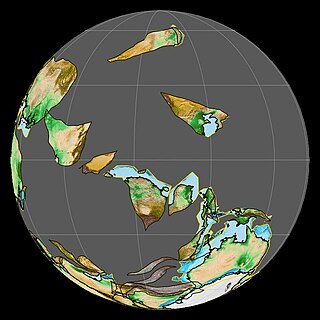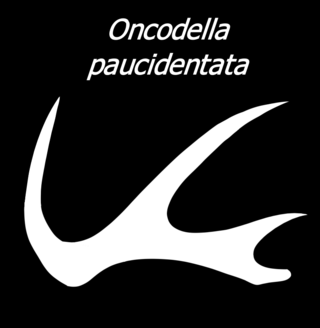Related Research Articles
The Permian is a geologic period and stratigraphic system which spans 47 million years from the end of the Carboniferous Period 298.9 million years ago (Mya), to the beginning of the Triassic Period 251.9 Mya. It is the last period of the Paleozoic Era; the following Triassic Period belongs to the Mesozoic Era. The concept of the Permian was introduced in 1841 by geologist Sir Roderick Murchison, who named it after the region of Perm in Russia.
The Guadalupian is the second and middle series/epoch of the Permian. The Guadalupian was preceded by the Cisuralian and followed by the Lopingian. It is named after the Guadalupe Mountains of New Mexico and Texas, and dates between 272.95 ± 0.5 – 259.1 ± 0.4 Mya. The series saw the rise of the therapsids, a minor extinction event called Olson's Extinction and a significant mass extinction called the end-Capitanian extinction event.
In the geologic timescale, the Artinskian is an age or stage of the Permian. It is a subdivision of the Cisuralian Epoch or Series. The Artinskian likely lasted between 290.1 and 283.5 million years ago (Ma) according to the most recent revision of the International Commission on Stratigraphy (ICS) in 2022. It was preceded by the Sakmarian and followed by the Kungurian.
The Bashkirian is in the ICS geologic timescale the lowest stage or oldest age of the Pennsylvanian. The Bashkirian age lasted from 323.2 to 315.2 Ma, is preceded by the Serpukhovian and is followed by the Moscovian.
In the geologic timescale, the Capitanian is an age or stage of the Permian. It is also the uppermost or latest of three subdivisions of the Guadalupian Epoch or Series. The Capitanian lasted between 264.28 and 259.51 million years ago. It was preceded by the Wordian and followed by the Wuchiapingian.
In the geologic timescale, the Wordian is an age or stage of the Permian. It is the middle of three subdivisions of the Guadalupian Epoch or Series. The Wordian lasted between 266.9 and 264.28 million years ago (Ma). It was preceded by the Roadian and followed by the Capitanian.

In the geologic timescale, the Wuchiapingian or Wujiapingian is an age or stage of the Permian. It is also the lower or earlier of two subdivisions of the Lopingian Epoch or Series. The Wuchiapingian spans the time between 259.51 and 254.14 million years ago (Ma). It was preceded by the Capitanian and followed by the Changhsingian.

The Visean, Viséan or Visian is an age in the ICS geologic timescale or a stage in the stratigraphic column. It is the second stage of the Mississippian, the lower subsystem of the Carboniferous. The Visean lasted from 346.7 to 330.9 Ma. It follows the Tournaisian age/stage and is followed by the Serpukhovian age/stage.

The Serpukhovian is in the ICS geologic timescale the uppermost stage or youngest age of the Mississippian, the lower subsystem of the Carboniferous. The Serpukhovian age lasted from 330.9 Ma to 323.2 Ma. It is preceded by the Visean and is followed by the Bashkirian. The Serpukhovian correlates with the lower part of the Namurian Stage of European stratigraphy and the middle and upper parts of the Chesterian Stage of North American stratigraphy.
The Kasimovian is a geochronologic age or chronostratigraphic stage in the ICS geologic timescale. It is the third stage in the Pennsylvanian, lasting from 307 to 303.7 Ma. The Kasimovian Stage follows the Moscovian and is followed by the Gzhelian. The Kasimovian saw an extinction event which occurred around 305 mya, referred to as the Carboniferous Rainforest Collapse. It roughly corresponds to the Missourian in North American geochronology and the Stephanian in western European geochronology.

Hindeodus is an extinct genus of conodonts in the family Anchignathodontidae. The generic name Hindeodus is a tribute to George Jennings Hinde, a British geologist and paleontologist from the 1800s and early 1900s. The suffix -odus typically describes the animal's teeth, essentially making Hindeodus mean Hinde-teeth.
Diplognathodus is an extinct genus of conodonts in the family Anchignathodontidae. Specimens are found in Carboniferous and Permian formations.
Neogondolellla is an extinct genus of conodonts. Neogondolela regalis was re-evaluated in 2018 by Martyn Lee Golding.
Heinz Walter Kozur was a German paleontologist and stratigrapher.
Neostreptognathodus is an extinct genus of conodonts from the Cisuralian.
Mesogondolella is an extinct genus of conodonts.
Jinogondolella is an extinct genus of conodonts.
Streptognathodus is an extinct genus of conodonts from the Late Carboniferous to Early Permian.
Conodonts are an extinct class of animals whose feeding apparatuses called teeth or elements are common microfossils found in strata dating from the Stage 10 of the Furongian, the fourth and final series of the Cambrian, to the Rhaetian stage of the Late Triassic. These elements can be used alternatively to or in correlation with other types of fossils in the subfield of the stratigraphy named biostratigraphy.

Oncodella is an extinct genus of Late Triassic conodont. The genus was given the type species Oncodella idiodentica by Mosher (1968), on the basis of fossils from the Late Triassic of Austria. However, Mosher (1969) later revised the species name to Oncodella paucidentata, since identical fossils from the same area were previously given the name Hindeodella paucidentata by Mostler (1967).
References
- ↑ Age and paleoecology of the conodont Clarkina changxingensis (Wang & Wang). Heinz Kozur, January 1992
- ↑ Kozur, Cour Forschungsinst Senckenb, 1990, volume 117, page 414
- ↑ Guadalupian (Middle Permian) Conodonts of Sponge-Bearing Limestones from the Margins of the Delaware Basin, West Texas. Kozur H. and Mostler H., Geologia Croatica, 1995, 48(2), pages 107-128 (abstract, retrieved 08 June 2016)
- 1 2 Palaeoecology of the conodonts Hindeodus and Clarkina during the Permian–Triassic transitional period. Xulong Lai, Paul Wignall and Kexin Zhang, Palaeogeography, Palaeoclimatology, Palaeoecology, Volume 171, Issues 1–2, 1 July 2001, Pages 63–72, doi:10.1016/S0031-0182(01)00269-3